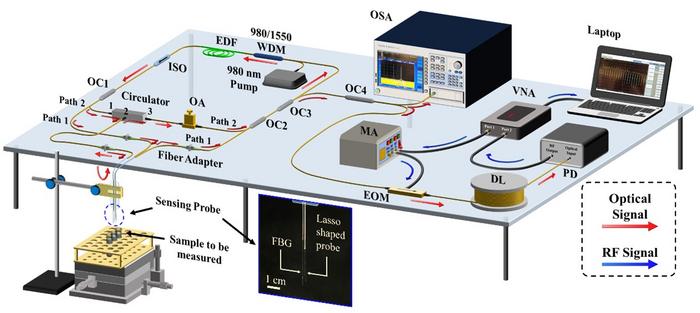
A groundbreaking study recently published in Opto-Electronic Advances unveils a novel approach to high-resolution tumor marker detection using a dual-wavelength fiber laser sensing system. This innovative technique is geared towards early cancer screening, tapping into the potential of microwave photonics for precise demodulation. The researchers, led by Professor Shao Liyang from the Southern University of Science and Technology, have made significant strides in addressing the pressing need for reliable detection of trace cancer markers present in bodily fluids such as blood and serum.
Detecting cancer markers early is crucial for timely treatment and accurate prognosis. The challenge lies in the extremely low concentrations of these markers, as well as the intricate nature of biological samples that make the detection process difficult. Traditional optical sensors often struggle with sensitivity and resolution, leading to less effective screening methods. This new research addresses these limitations by exploring the ability of optical fiber sensors to integrate optical detection and signal transmission, thus enhancing their performance.
The innovative system proposed by the research team includes a self-assembling micro-lasso-shaped optical fiber sensor paired with fiber Bragg grating technology. This configuration generates dual-wavelength laser output, which is then analyzed using microwave photonics. This unique demodulation technology facilitates a deeper examination of the sensing signals, allowing for a more nuanced understanding of the spectral information being captured.
During experimental evaluations, the researchers employed three distinct demodulation schemes to assess the performance of their system. These included the analysis of spectral wavelength shifts, the evaluation of Free Spectral Range (FSR) variations in the resulting radiofrequency (RF) spectra, and the investigation of reductions in maximum Notch frequency in RF spectra. This multifaceted approach promised a comprehensive understanding of the detection capabilities of their novel biosensor system.
When it comes to the sensitivity of this new detection method, the research team achieved impressive results. The refractive index (RI) sensitivity of the proposed biosensor system reached an impressive 1083 nm/RIU through wavelength demodulation. In parallel, they recorded RI sensitivities of -535.56 GHz/RIU and -1902 GHz/RIU through FSR reduction and maximum Notch frequency reduction analyses, respectively. This demonstrates a remarkable capacity for the sensor system to discern minute changes in optical signals corresponding to trace cancer markers.
Further investigation revealed a dramatic enhancement in ideal detection resolution, which improved from 1.9×10^-5 RIU to an astonishing 1.87×10^-7 RIU and 5.26×10^-8 RIU for the different demodulation methodologies implemented. This performance leap effectively granted the system a two- to three-order-of-magnitude improvement compared to existing techniques in the realm of optical fiber sensing, opening up vast possibilities for early cancer detection.
To put the functionality of the biosensor to the test, the team chose CEACAM5 as their target marker, an important cancer-associated biomarker. The sensitivity and accuracy of the testing system were astounding, with results indicating a Limit of Detection (LOD) as low as 0.076 ng/mL. This detection capability represents a significant advancement over conventional laser spectral wavelength demodulation schemes, which often struggle to selectively identify such low concentrations.
In addition to demonstrating the sensor’s capabilities in controlled environments, the research team also conducted trials using human serum samples. The results effectively showcased the sensor system’s practical applications, as it successfully discriminated between differing levels of tumor markers in various samples. The outcomes corroborated clinical values provided by medical facilities, illustrating the sensor’s potential for incorporation into real-world medical diagnostics.
This advancement in microwave photonics-based demodulation brings forth a promising avenue for the future of optical fiber biosensors, transforming how cancer screenings might be approached. Unlike traditional methods reliant on wavelength monitoring via optical spectral analyzers, the novel method enhances detection accuracy and resolution, ultimately improving the likelihood of catching cancer at its earliest stages.
The research, led by esteemed academic professionals, exemplifies a blend of interdisciplinary collaboration, marrying concepts of microwave technology with cutting-edge optical sensing. The innovation presented not only holds potential for cancer detection but also paves the path for broader applications in the field of biomedical diagnostics, showcasing how continuous scientific advancements can lead to impactful solutions.
As the authors of the study harmonize their findings with the requirements of modern healthcare demands, it is evident that their work contributes significantly to the field of optical sensing and cancer detection technology. The implications of their research extend beyond academia, promising to influence clinical practice and improve patient outcomes across the globe.
Such advancements herald a new era in oncological diagnostics, where early detection through sophisticated sensing technology could become as routine as a standard blood test. The fusion of physics with biomedical applications signifies a transformative leap that may soon redefine the healthcare landscape, inspiring hope in early cancer detection methodologies.
Given the serious implications for patient care, this innovative study stands to garner significant attention in scientific communities and the public sector alike, igniting discussions about the future of cancer diagnostics and treatment methodologies.
In summary, this cutting-edge research serves as a testament to the potential embodied in the fusion of technology and healthcare, emphasizing the need for ongoing exploration and innovation in the realm of medical diagnostics. As it stands, the advancements made through this study promise to reshape the future of cancer detection, heralding a brighter, more informed pathway toward combating this pervasive disease.
Subject of Research: High-resolution tumor marker detection using microwave photonics demodulated dual wavelength fiber laser sensor.
Article Title: High-resolution tumor marker detection based on microwave photonics demodulated dual wavelength fiber laser sensor.
News Publication Date: 2024
Web References: DOI Reference
References: Opto-Electronic Advances
Image Credits: Credit: OEA
Keywords: optical fiber sensor, optical fiber laser, microwave photonics demodulation, high-resolution detection, tumor marker detection.





